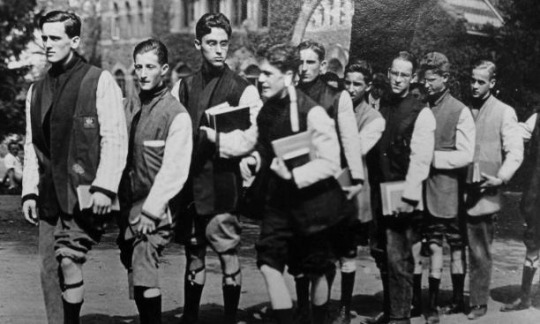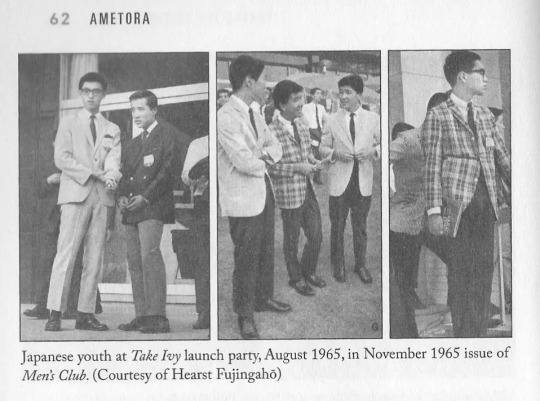#avery trufelman
Link
Put on your Docksiders for a stroll through history with Avery Trufelman, who shows us how Ivy style became “preppy,” and how preppy fashion escaped the campus and took over the world. We’re talking about clothing, class, race, and the American dream: you may be through with the polo shirt, but the polo shirt isn’t through with you.
Here's where to find Avery:
Articles of Interest on Substack
Articles of Interest podcast
#Where Have All the Preppies Gone#you're wrong about podcast#podcasts#podcast#you're wrong about#Articles of Interest#Avery Trufelman#cultural critique#Society and Culture#pop culture#culture#cultural criticism#fashion history#fashion#history#clothes#preppy#polo shirt
7 notes
·
View notes
Text


I'm fascinated by a new podcast, Articles of Interest, by Avery Trufelman. It's about clothing—what we wear, why we wear it, and what it says about us as people. They did a series a couple of years ago, and now they're back with a new season.
The new season is about Ivy style--better known, to me at least, as "preppy" clothes. The podcast traces Ivy style to Princeton University in the 1920s-30s, and ties it all together with Japan from the 1800s to the 1960s, England in the 20s and 30s, manufacturing and democracy in the US, and Brooks Brothers (which is, apparently, the oldest continuously running company in the US).
Ivy style is so ubiquitous we don't even notice it. In the West and much of the rest of the world, Ivy style is how most people dress most of the time, including midcentury Black jazz musicians, Jack Kerouac and Allen Ginsberg. Here's a summary of the second episode in the series (which I listened to first), with lots of excellent photos.
3 notes
·
View notes
Text
I think in American society, it's never been very cool to be wealthy, and the wealthy people I know have always hidden it. So I think that’s a part of it. I also feel like it's not entirely about wealth.
The trend forecasters I talked to were like, it's kind of about looking like you have your shit together. It's about looking smart and looking on top of things and looking sophisticated. I'm sure that's a part of reentering public life — I'm going to dress to be legible to other people. So sure, some of it is about wealth, but I think some of it is like, the legibility and accessibility and ease of this style. That basically says, “Hello, how are you?” And, “Trust me.”
Avery Trufelman on the rise of 'stealth wealth' and 'quiet luxury' [x]
1 note
·
View note
Text
I listened to the newest episode of No Bad Ideas and Avery Trufelman described her early work at 99% Invisible as “asking smart people dumb questions” which is the tagline of Ologies with Alie Ward.
One female podcaster who makes a broad-audience topic-of-the-week podcast acknowledging the work of another. We love to hear it
0 notes
Text
when i get a slutty little transmasc haircut and finally make plans to hang out with my friend so they can give me their SUPER cute pvc(? could have been something else but looked like pvc. btw there's a really interesting episode of a fashion podcast called articles of interest where they talk about paper dresses and rubber/latex/pvc fashion and culture and it's fascinating. would highly recommend. the episode about plus size clothing is really good too. they get into the cold shoulder trend in plus size fashion and it's like. just as stupid and sinister as you might imagine.) zip up crop top. then U will see ...
#and a couple more ear piercings. while we're at it.#ALSO the knockoffs episode of articles of interest is really good. it's a good podcast and avery trufelman is so good at her job.
9 notes
·
View notes
Text
I find it a frustrating trend that fashion/textile history writers are just incredibly ignorant or unwilling to engage in the actual economics or, really, oppressive systems, involved the creation of clothing.
I find this in the blatently fake "historians" like Systlin but also in more thoughtful or informed people. For example, I like a lot of Avery Trufelman's work and I liked her episod of You're Wrong About but it's amazing, just amazing, that she does a whole history of fashion in the 1980s and 1990s but never mentions NAFTA once, never mentions the collapse of the American garment industry in the 1980s, never mentions the WTO. The more egregious versions of this are the astoundingly large number of people writing/talking about 19th century fashion with not a single mention of British colonialism in India or American Slavery.
This is a crew of people who love to reference the Miranda Priestly monologue about how thoughtful and complex fashion is....but perhaps would benefit from hearing another kind of condescending monologue that, e.g., starts, "IMF enforced structural adjusment policies in Indonesia, leading to the explosive growth of factories making clothing for export and continuing the decimation of the unionized garment workforce in the U.S....."
And, of course, what irritates me the most is the weird stance that this lack of concern with Marxist analysis, ethics or just human suffering is a cool feminist stance and not just shallow and morally bankrupt.
514 notes
·
View notes
Text
Imaginary Advice | 100th Episode
(feat. Avery Trufelman, Eric Molinsky, Helen Zaltzman,
Joe Dunthorne & Joseph Fink)
4 notes
·
View notes
Text

“I came to J. Press for its fascinating story and legacy, but came to fall in love with its superior quality and timeless style. And I love how the two elements go together: I get so many compliments from strangers when I'm in a J. Press sweater, and then I get to tell them about this fascinating history.”
J. Press Icons: Avery Trufelman & the Navy Blazer
10 notes
·
View notes
Text
do you like fashion and podcasts? listen to this one it's pretty cool
8 notes
·
View notes
Text
FAS3001 Historical Research


When I conducted my main research for the key elements of the trend, I discovered that much of the influences lie in the past, particularly in the last century. Indeed, Avery Trufelman on her podcast, Articles of Interest, explored across the series how the Ivy style evolved; starting in Ivy League universities in the United States, students would dress in a very specific style that was admired by the rest of the world. This was summarised by the creation of Take Ivy (Hayashida, 1956), an observational book made by Japanese fashion enthusiasts, who made visual references of the outfits these students wore at the time. After the development of the style over many years, it fluctuated in popularity due to the different connotations that were seen as either socially desirable or undesirable at different points in history. For example, in episode three of the Articles of Interest podcast, (Trufelman, 2022) explored how it eventually became “uncool” to dress in the Ivy style as it had essentially become the new basic style of the students at the universities. Arguably this could have been due to the admission of women to universities as these events coincided, but it could equally be just a natural dip in the trend cycle of the style. Similarly, it is important to note that the style never truly became “uncool” but instead adapted naturally witn the other popular styles of the time. Nonetheless, similar fabrics and silhouettes stayed persistent throughout the whole period, with the only adaptations being in details like the width of lapels or the way in which a garment was worn. For example, it became very popular for people to roll up elements of their clothes like the arms or legs, which prior to this would not have been typically socially acceptable outside of the educational context. More consistently, however, was the use of fabrics and patterns which remained largely similar throughout the history of the Ivy style. This was evident as patterns like houndstooth, argyle, and tweed remained very popular throughout the period. In a similar manner, the colours that were used also remained similar; most of the garments were created in dark, deep, organic colours, with only a few splashes of colour. I plan to amalgamate the original Ivy style, and the developed 1970s/80s preppy style, creating a more modern twist on the both historically set styles of clothing.
I shall use this information to further my own development by using reference images from history too, to make sure this historical aspect of the trend is recognised. Similarly, I shall ensure all my fabric and colour choices are informed by references throughout history, as it is clear that the historical popularities in style will be an influence on the trend forecast.
Hayashida, T (1956) Take Ivy. powerHouse Books
Trufelman, A (2022) Articles of Interest- American Ivy: Chapter 3. [podcast] Available at: https://www.articlesofinterest.co/podcast/episode/3299220a/american-ivy-chapter-4 [accessed 24 December 2022]
Roberts, J (1980) The Official Preppy Handbook. Workman publishing
5 notes
·
View notes
Link
99 Percent Invisible producer emeritus Avery Trufelman traveled from New York to San Francisco recently, and took host Roman Mars to see an unusually shaped old building on the west side of the Bay.
As it turns out, this peculiar octagonal home isn’t unique — there was a whole architectural fad of building these back in the mid 1800s, tapping into a parallel trend: self-improvement.
#The Octagon House - 99% Invisible#Avery Trufelman#Roman Mars#Octagon House#99% Invisible#architectural#Architecture#San Francisco#podcast#podcasts#home#homes#house design#history#architectural history
6 notes
·
View notes
Text
“The Corduroy Appreciation Society was a club where people gathered secretly to celebrate their love of corduroy." On the delightful Articles of Interest podcast with Avery Trufelman.
2 notes
·
View notes
Text
Before this all I knew about preps was that it's something goths don't like based on my immortal. Super interesting to learn the history of preppy fashion and how it expanded to where it's ubiquitous enough to not need to be remarked on.
3 notes
·
View notes
Text
2 notes
·
View notes
Text
one thing about avery trufelman is she's gonna describe fabric or a piece of clothing as sumptuous. and one thing about me is i'm gonna love it every time.
#articles of interest is one of my favoriteeeeeee podcasts#im sad its going on hiatus but i will live
0 notes
Text
it’s not about fashion, it’s about clothing. Cars fall in and out of fashion; interiors fall in and out of fashion, and clothing … I mean, it’s a massive percentage of the waste in the world. It was a driving force behind the industrial revolution, the power loom, and the jacquard punch card loom paved the way for the punch card computer. It set the groundwork for the institution of American slavery. Clothing is so important and so I just wanted to find a way to talk about it.
Avery Trufelman
0 notes